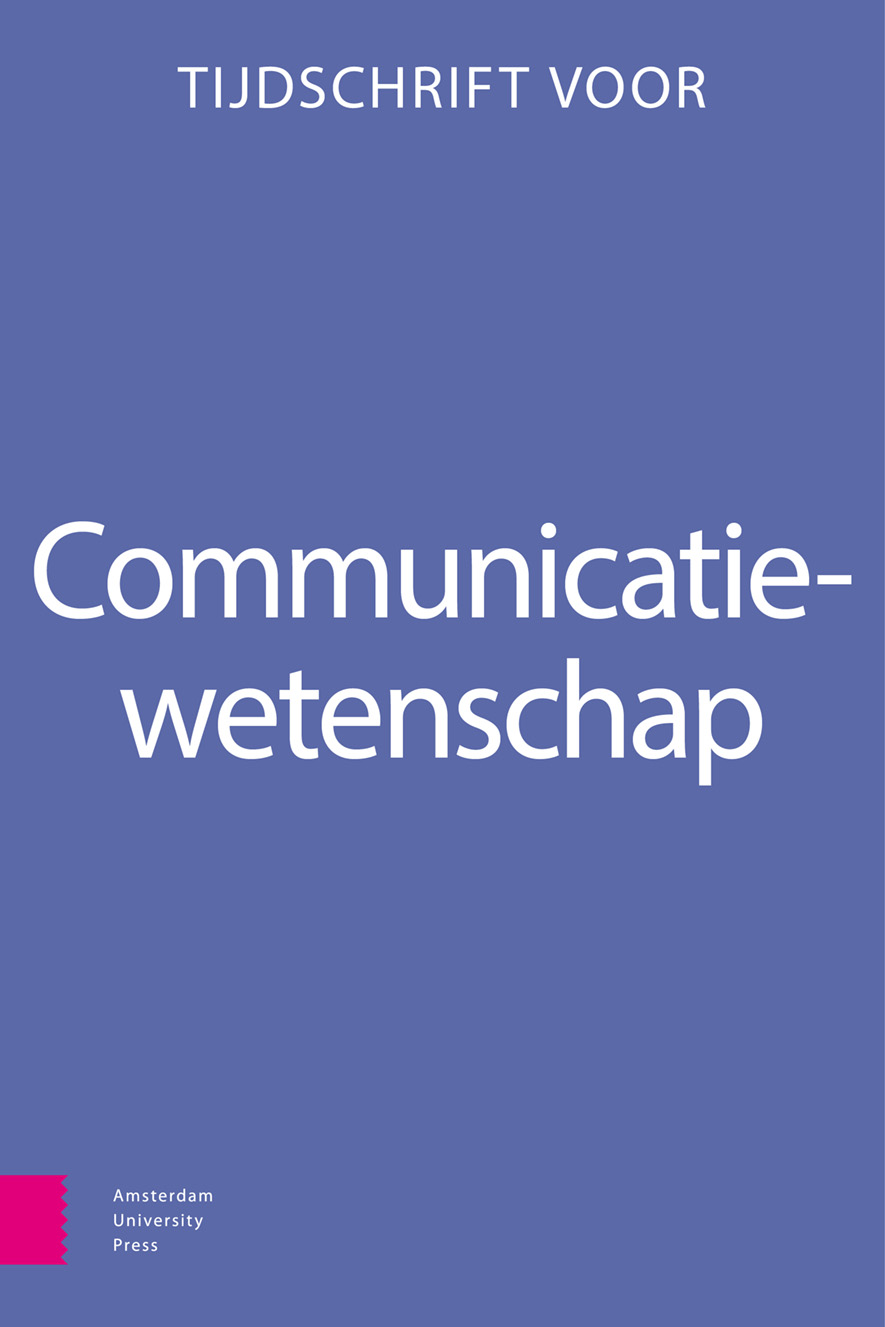- Home
- A-Z Publications
- Tijdschrift voor Communicatiewetenschap
- Previous Issues
- Volume 40, Issue 4, 2012
Tijdschrift voor Communicatiewetenschap - Volume 40, Issue 4, 2012
Volume 40, Issue 4, 2012
Language:
Dutch
-
-
Redactioneel
More LessVeertig jaar geleden, in de herfst van 1972, verscheen het allereerste nummer van het Tijdschrift voor Communicatiewetenschap, toen nog Massacommunicatie geheten. Guido Fauconnier (Katholieke Universiteit Leuven), James Stappers (Katholieke Universiteit Nijmegen), Paul Hendriksen (Nederlandse Omroep Stichting) en Eldert Willems (Universiteit van Amsterdam) vormden destijds de redactie. In 1996, jaar Read More
-
-
-
Negatieve reacties van vrouwen op seksuele videoclips
More LessAuthors: Johanna M.F. van Oosten & Inge BootWomen’s resistance to sexual music videos: the role of involvement and dissonance Women’s resistance to sexual music videos: the role of involvement and dissonance Research on sexual music videos has paid little attention to the possibility that viewers can resist sexual music videos and has largely ignored the processes that may explain this resistance. The present study aimed to fill these gaps in the literature. In an Read More
-
-
-
Seksuele objectivering in een vampierenromance
More LessAuthors: Laura Vandenbosch, Eline Frison & Steven EggermontSexual objectification in a vampire romance: An experimental study towards the effect of the movie Twilight on self-objectification among adolescent girls Sexual objectification in a vampire romance: An experimental study towards the effect of the movie Twilight on self-objectification among adolescent girls The present study investigates whether self-objectification is induced by exposure to a popular, but sexually obje Read More
-
-
-
Stereotypering, ideologie en beïnvloeding in digitale games
More LessAuthors: Steven Malliet & Wannes RibbensStereotypes, ideology and persuasion in America’s Army Stereotypes, ideology and persuasion in America’s Army This study investigates the influence of the shooting game America’s Army on players’ cognitions and attitudes towards Muslims and the army. In order to reconcile two contrasting views on game rhetoric (the framing and the critical reflection perspective), the perceptions and involvement of the player a Read More
-
-
-
Zijn sponsorvermeldingen in televisieprogramma’s effectief?
More LessAuthors: Sophie C. Boerman, Eva A. van Reijmersdal & Peter C. NeijensAre sponsorship disclosures in TV programs effective? Are sponsorship disclosures in TV programs effective? Due to concerns about the possible deceptiveness of sponsored content in television programs, the EU decided to make sponsorship disclosure obligatory. The goal of sponsorship disclosure is to raise awareness of sponsored content so viewers can guard themselves against persuasion. This study explores how spo Read More
-
-
-
Meerdere schermen in de huiskamer
More LessAuthors: Evelien D’heer, Steve Paulussen & Cédric CourtoisMultiple screens in the living room: a study on simultaneous media use Multiple screens in the living room: a study on simultaneous media use Today’s (home) media environment is becoming increasingly saturated. Smartphones, tablets and laptops enter our living rooms and possibly alter our television viewing experience. In this paper, we want to grasp to what extent the use and role of television changes in the presence Read More
-
-
-
Effecten van synchroon bewegen op groepspercepties en coöperatief gedrag bij middelbare scholieren
More LessAuthors: Ivar Vermeulen & Esther WeijkampEffects of movement synchrony on ingroup perceptions and cooperation among high school children Effects of movement synchrony on ingroup perceptions and cooperation among high school children Synchronous movement (e.g., marching, clapping) is a well-established practice to strengthen social bonds. Nevertheless, research on its effectiveness is scarce. We investigate effects of synchronous group movement o Read More
-
-
-
Journalistiek en politiek in onzekere tijden
More LessBy Eva de SmedtJournalistiek en Politiek in Onzekere Tijden
-
-
-
Jaaroverzicht 2012
More LessSophie C. Boerman, Eva A. van Reijmersdal & Peter C. NijensZijn sponsorvermeldingen in televisieprogramma’s effectief?
-
Volumes & issues
-
Volume 53 (2025)
-
Volume 52 (2024)
-
Volume 51 (2023)
-
Volume 50 (2022)
-
Volume 49 (2021)
-
Volume 48 (2020)
-
Volume 47 (2019)
-
Volume 46 (2018)
-
Volume 45 (2017)
-
Volume 44 (2016)
-
Volume 43 (2015)
-
Volume 42 (2014)
-
Volume 41 (2013)
-
Volume 40 (2012)
-
Volume 39 (2011)
-
Volume 38 (2010)
-
Volume 37 (2009)
-
Volume 36 (2008)
-
Volume 35 (2007)
-
Volume 34 (2006)
-
Volume 33 (2005)
Most Read This Month
Article
content/journals/13846930
Journal
10
5
false
en


